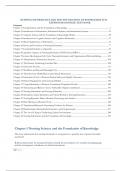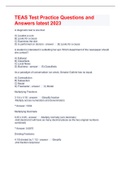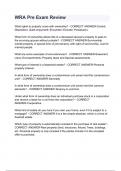NURSING INFORMATICS AND THE FOUNDATION OF KNOWLEDGE 4TH
EDITION MCGONIGLE TEST BANK
Contents
Chapter 1 Nursing Science and the Foundation of Knowledge........................................................................................ 1
Chapter 2 Introduction to Information, Information Science, and Information Systems ..........................................19
Chapter 3 Computer Science and the Foundation of Knowledge Model .....................................................................38
Chapter 4 Introduction to Cognitive Science and Cognitive Informatics .....................................................................57
Chapter 5 Ethical Applications of Informatics ..................................................................................................................74
Chapter 6 History and Evolution of Nursing Informatics...............................................................................................77
Chapter 7 Nursing Informatics as a Specialty ....................................................................................................................81
Chapter 8 Legislative Aspects of Nursing Informatics: HITECH and HIPAA ...........................................................84
Chapter 9 Systems Development Life Cycle: Nursing Informatics and Organizational DecisionMaking ............ 101
Chapter 10 Administrative Information Systems ........................................................................................................... 104
Chapter 11 The Human-Technology Interface Dee ...................................................................................................... 108
Chapter 12 Electronic Security .......................................................................................................................................... 111
Chapter 13 Worldlow and Beyond Meaningful Use ...................................................................................................... 129
Chapter 14 The Electronic Health Record and Clinical Informatics .......................................................................... 133
Chapter 15 Informatics Tools to Promote Patient Safety and Quality Outcomes .................................................... 136
Chapter 16 Patient Engagement and Connected Health ............................................................................................... 159
Chapter 17 Using Informatics to Promote Community/Population Health ............................................................. 180
Chapter 18 Telenursing and Remote Access Telehealth: Original contribution ....................................................... 191
Chapter 19 Nursing Informatics and Nursing Education ............................................................................................. 200
Chapter 20 Simulation, Game Mechanics, and Virtual Worlds in Nursing Education............................................. 214
Chapter 21 Nursing Research: Data Collection, Processing, and Analysis................................................................. 218
Chapter 22 Data Mining as a Research Tool ................................................................................................................... 242
Chapter 23 Translational Research: Generating Evidence for Practice ...................................................................... 246
Chapter 24 Bioinformatics, Biomedical Informatics, and Computational.................................................................. 271
Chapter 25 The Art of Caring in Technology-Laden Environments .......................................................................... 288
Chapter 26 Nursing Informatics and the Foundation of Knowledge ......................................................................... 303
Chapter 1 Nursing Science and the Foundation of Knowledge
The nurse understands that nursing informatics is recognized as a specialty area of practice bywhich
statement?
1. Research priorities for nursing informatics include the development of a standard nursinglanguage
and the development of databases for clinical information.
1|Page
,2. A formal educational program at the master's level must be completed before a nurse iseligible to
sit for the credentialing examination.
3. As a differentiated practice, nursing informatics is focused upon the client, the environment,health, and
the nurse.
4. There is a need for nursing informatics interests to gain representation by work groups and
organizations within the United States.
Correct Answer: 1
Rationale 1: The development of research priorities is a key point in a specialty practice. Although degrees
at the master's level are available, the degree required for credentialing is typically at the bachelor's level and
includes experience in the field. Current demands for safer,cost-effective, quality care require evidence of
the best practices supported by research.
Rationale 2: Such a formal educational program does not necessarily mean a specialty area ofpractice.
Although degrees at the master's level are available, the degree required for credentialing is typically at the
bachelor's level and includes experience in the field. The development of research priorities is a key point
in a specialty practice.
Rationale 3: Your chosen response refers to the entire discipline of nursing. The specialty of nursing
informatics integrates nursing science, computer science, and information science to manage and
communicate data, information, knowledge, and wisdom into nursing practice. Thedevelopment of research
priorities is a key point in a specialty practice.
Rationale 4: There are many work groups in the United States related to informatics that focus on the
specialty of informatics practice. One example is the Nursing Informatics Special InterestGroup of the
International Medical Informatics Association. The development of research priorities is a key point in a
specialty practice.
Global Rationale:
Cognitive Level: Understanding
Client Need: Safe Effective Care Environment
Client Need Sub: Management of Care
Nursing/Integrated Concepts: Nursing Process: Assessment
Learning Outcome:
Question 2 Type:
MCSA
Which statement by the nurse verifies that the nurse is "information literate"?
1. "I understand how to search for a website and evaluate its usefulness for health care needs."
2. "I utilize databases in the health care setting to input client information such as skin
condition."
3. "I use email over the Internet to correspond with clients and provide information."
2|Page
,4. "I can use software applications such as word processing, spreadsheets, and presentations."
Correct Answer: 1
Rationale 1: Information literacy necessitates that nurses have the ability to find, evaluate, and effectively use
information. The other answers are examples of computer literacy but do not havethe higher functions of
information literacy.
Rationale 2: Your chosen response is an example of computer literacy, but it does not have thehigher
functions of information literacy. Information literacy necessitates that nurses have the ability to find,
evaluate, and effectively use information.
Rationale 3: Your chosen response is an example of computer literacy but, it does not have thehigher
functions of information literacy. Information literacy necessitates that nurses have the ability to find,
evaluate, and effectively use information.
Rationale 4: This answer is an example of computer literacy but, it does not have the higher functions of
information literacy. Information literacy necessitates that nurses have the ability tofind, evaluate, and
effectively use information.
Global Rationale:
Cognitive Level: Understanding
Client Need: Safe Effective Care Environment
Client Need Sub: Management of Care Nursing/Integrated
Concepts: Nursing Process: PlanningLearning Outcome:
Question 3 Type:
MCSA
The nurse gathers much data when caring for clients. Which is an example of the higher-level
"information" useful in caring for clients?
1. The vital signs are BP of 130/70, HR of 88, RR of 24, temperature of 98.8 degrees F., andoxygen
saturation of 98%.
2. Lab work results include an electrolyte panel and complete blood count with differential.
3. The client is a widowed 64-year-old black male admitted with prostatitis.
4. After receiving Rocephin (ceftriaxone sodium) 1.0 gram IV yesterday, the client reportedfeeling
better today.
Correct Answer: 4
Rationale 1: Your chosen response is an example of having pieces of data without interpretation.
"Information" necessitates that the nurse interpret and structure the results of clinical data into information.
Rationale 2: Your chosen response is an example of having pieces of data without interpretation.
3|Page
, "Information" necessitates that the nurse interpret and structure the results of clinical data into information.
Rationale 3: Your chosen response is an example of having pieces of data without interpretation.
"Information" necessitates that the nurse interpret and structure the results of clinical data into information.
Rationale 4: "Information" necessitates that the nurse interpret and structure clinical data into
information. It can then be used to aid clinical decision making and client monitoring. All otherresponses
included pieces of data without interpretation.
Global Rationale:
Cognitive Level: Understanding
Client Need: Safe Effective Care Environment
Client Need Sub: Management of Care
Nursing/Integrated Concepts: Nursing Process: Assessment
Learning Outcome:
Question 4 Type:
MCSA
Which statement best distinguishes the difference between information literacy and computerliteracy?
1. Information literacy is unnecessary in health care whereas computer literacy provides the basisfor
computer order entry.
2. Information literacy is the foundation of the EHR whereas computer literacy helps the nurse toaccess data.
3. A nurse can extrapolate data with computer literacy and not information skills.
4. Information literacy forms the basis for ongoing learning whereas computer literacy refers to afamiliarity
with the use of personal computers.
Correct Answer: 4
Rationale 1: Computer literacy is a popular term used to refer to a familiarity with the use of personal
computers, including the use of software tools such as word processing, spreadsheets,databases,
presentation graphics, and e-mail. The majority of students admitted to nursing schools now enter with
some level of computer literacy.
Rationale 2: Computer literacy is a popular term used to refer to a familiarity with the use of personal
computers, including the use of software tools such as word processing, spreadsheets,databases,
presentation graphics, and e-mail. The majority of students admitted to nursing schools now enter with
some level of computer literacy.
Rationale 3: Computer literacy is a popular term used to refer to a familiarity with the use of personal
computers, including the use of software tools such as word processing, spreadsheets,databases,
presentation graphics, and e-mail. The majority of students admitted to nursing schools now enter with
some level of computer literacy.
Rationale 4: Computer literacy is a popular term used to refer to a familiarity with the use of personal
computers, including the use of software tools such as word processing, spreadsheets,databases,
presentation graphics, and e-mail. The majority of students admitted to nursing schools now enter with
4|Page






